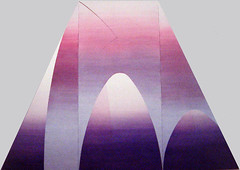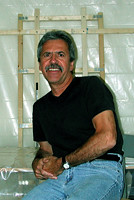Metaphor For The Sublime/Devonna Pieszak
Metaphor
For The Sublime
The Christian Science Monitor, 1988
Devonna Pieszak
The 20th-century artist often seems like a quasi-scientist. He experiments with line, form, color, and space, explores new materials and technologies, and seeks to expand the definitions of what art can be and include. The first abstractionists wanted to purge art of the representational. They often felt that the content of their work was metaphysical, mystical, or metaphorical.
In the early 1900’s the Russian artist Casmir Malevich Malevich sought “pure expression without representation” and cleared the decks quickly. He sounded a primitive chord by placing a black square on a white background. Wassilly Kandinsky sought the “spiritual” in complex harmonies in his multitonal expressionistic abstractions. Piet Mondrian, who felt that man’s existence was becoming more abstract and divorced from natural objects, erased all but the calming chords of vertical and horizontal oppositions played against the counterpoint of primary colors.
Dan Smajo-Ramirez echoes the concerns of these artists. He incorporates the idea of the sublime in his art, but he rephrases it into his own distinctive song. Like all of them he views abstraction as a conveyance for feeling.
Smajo Ramirez’s paintings take their basic shape from geometric form – the trapezoid, rectangle, or triangle. The inspiration for them is based on an elaborate intellectual structure inclusive of philosophy (Wittgenstein ), music (Webern and Messiaen), theology (Aquinas, and 19th-century German Romantic landscape painting (Caspar David Friedrich).
The paintings, however, that spring from this specific, scholarly mix become approachable, contemplative refuges where light is the distinguishing feature and ambiguity a surprising constant. His painting has been shaped by his single-minded pursuit of metaphors for the sublime and his desire to create representations of the spiritual.
To do this he has, in an interesting reversal, incorporated the romantic ideals of Friedrich, who, like Smajo-Ramirez, wanted to depict “the ineffable, the immeasurable” with a “sense of distance and expanse” by portraying “the immensity of the elements found in nature” – the sea, the plain, the sky. (Interestingly these elements are very much a part of the real landscape around Chicago, where Smajo-Ramirez has lived). The phenomena of light and atmosphere – fog, twilight, clouds, haze, setting sun – were part of Friedrich’s means of making “infinity perceptible.”
Light and atmosphere are also Smajo-Ramirez’s principle means of transmitting his ideal. He has, however, controlled his romantic fervor by enclosing it in the calming rigors of geometric form. In his highly poetic paintings, the precise forms are tranquilized by a benign atmosphere that is ambiguous, being imprecisely water, mist, or serene light of no known source or substance other than the paint itself.
In the elegant painting “Celestial City No.9” we see how Smajo-Ramirez captures an ethereal atmosphere within a trapezoid form. This painting appears to be made up of two distinct flat planes. The back plane starts at the bottom with dark washes of a deep violet – whose wavelike value modulations fade into a pale hue. It is a monochromatic scale in which the color vaporizes. The faint echolike arcs within this light become a major chord on the front plane.
This plane is divided into three sections, each with a graceful arc or arch implying a building without defining one. Here the darkest shading of reddish and silver gray hues starts near the top, fading out in either direction. The center arch panel of this plane also appears to be slightly concave.
To add another voice to his polyphonic mix, he has drawn incisive lines on top of this front plane. Two of these define the panels – implying their separation – and the others play arc like melodies across the surface and remind us of the paintings “real” opacity.
In these ways Smajo-Ramirez has set up a series of ambiguities over which the eye moves gracefully, shifting between the concrete and the ethereal. The complex visual fluctuation and interaction have created the illusion of space that seems strictly and narrowly defined. At the same time it is emotionally expansive, implying an infinite atmosphere barely contained within the explicit geometry.
Recently Smajo-Ramirez has added more obvious, three-dimensional ideas to his paintings as in “Veritas/Lumen/Res No.10.” Here the previous spacious quietude is jarred somewhat, and delicate nuances are punctuated by more insistent curves carving into the painting.
Contrasting the ethereal background with the now more obviously concrete foreground, he has defined the idea of a window or passage with actual perspective lines and an implied perspective on the arc side. These lines poke holes in the flat planes they outline, forcing the misty gray light back and a bright yellow to shine in a chink.
Smajo-Ramirez reinforces the presence of an implied architecture with the help of a heavy purple impasto of block-like brushstrokes on the arc section. These strokes lighten in color into the pale yellow of the gel medium that gives the paint its texture. Simultaneously the sharp black lines also repeat the two-dimensionality of the painting.
The painter has manipulated geometric shapes and paint into a complex metaphorical statement that matches the intellectual structure that acts as its inspiration.
These are beautiful paintings, but their deliberate complications seem nonetheless to be simple fragments from a landscape of light. Their exactness of measure and proportion contributes significantly to the feeling that they are harbors within which we can find a measure of spiritual refreshment.
Return to Ramirez@Luz Web Site



0 Comments:
Post a Comment
<< Home